New Style Pallet Racking

Teardrop Pallet Racking

Hiline Racking
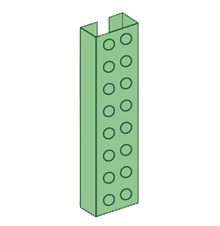
Republic/Keystone Racking
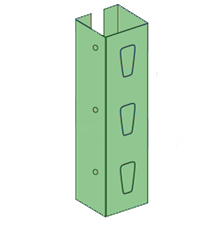
Paltier Racking

Penco Racking
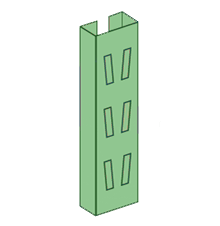
Ridg-U-Rak Racking
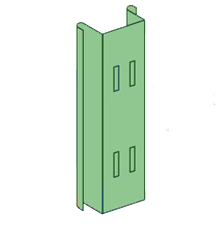
Speedrack Racking

Structural Racking
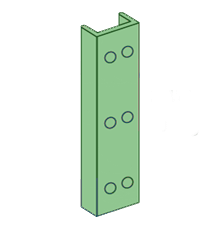
Sturdi-Bilt Racking
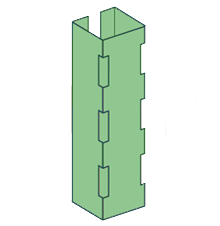
Unarco T-Bolt Racking
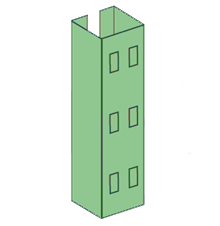
Webb Slide-N-Lock Racking

Artco

Buckley

Burtman

D’Altrui

Dexion
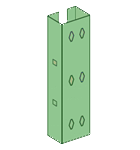
EMI

Frick Gallagher

Husky Crashguard

Inca
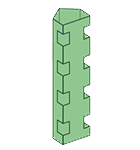
Lok-Rack
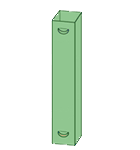
Palmer Schile

Sammons

Unarco II

Selective Pallet Rack Systems
Roll Formed Pallet racking is built from Sheets of “Cold Rolled” steel that are bent to a desired shape using roll forming machines. This is the case for both the pallet rack uprights and the beams.
Structural pallet racking is built from “Hot Rolled” steel components that are each formed to a desired shape while the steel is still at a high enough temperature to be manipulated by a machine.
Common Components of Selective Rack
Beams: The beams in the selective pallet rack system can be either box beams, step beams or C-Channel type structural beams.
- Step Beams are designed with a step on the top which enables wire decking, pallet supports and other items to sit in the step to create a beam or shelf level within the racking bay. This step is typically 1 5/8” deep and is located at the top inside edge of the step beam. Located on each end of the step beams are connector clips which enable the beams to be attached to the uprights. These connectors have a variety of pins or hooks that connect to the upright itself.
- Box beams are made from the same roll formed steel but do not have the step on them. They are actually square shapes like a box. They too have the same type of connectors that the step beams do.
- Structural Beams are made from structural steel. The beam body itself is basically a C-Channel with a connector clip welded on both ends like the step and box beams. The connectors for the structural beams can by similar to the connectors for the roll formed beams. However, they are generally a bolt on type connector that enables the structural beam to be attached to the upright frame by running a bolt though the beam connector and the upright face and installing a nut on the bolt from the back side of the upright.
Uprights: These are typically referred to as uprights, upright frames or simply frames.·
- Roll formed uprights like the roll formed beams are built from “Cold Rolled” sheets of steel that are bend to the desired shape. They have specific holes punched in their face to allow for the beam connection. These holes come in a variety of styles. The most prevalent hole design on the market today is called a “Tear Drop” design. This design basically resembles and upside down tear drop.
- Structural uprights like the structural beams are built from structural components. They have round holes punched in their face that enable the round hole beam connectors to attach to the upright with the nut and bolt system. Structural uprights generally provide a higher capacity than the roll formed uprights.
Row spacers: Row spacers are used to tie the rows of pallet racking together when they are standing. These come in a variety of lengths based on particular storage requirements. The most typically length is 12” Long. They add rigidity to the pallet rack system to prevent toppling of the pallet racking sections.
Selective Pallet Rack Aisle Configurations
Standard Aisles: When you are considering the use of pallet racking in your warehouse the objective is to achieve as many pallet positions of various products that you can in a given space. Many counterbalance sit-down type forklifts will only operate safely in an standard aisle that is at least 12 feet to 12-1/2 feet wide. These wide aisles will generally reduce the number of pallet positions of storage that can be created within your warehouse space. If the counterbalance sit-down forklifts are what you currently have or they are what is needed for your particular application, then the standard aisle configuration may be the best choice. Narrow aisles mean more products in your warehouse! You might consider purchasing additional forklifts that will work within a narrow aisle application which could gain you a reduction in required aisle spacing by a minimum of 40%. Simply put, in a general selective pallet racking application the narrower the aisle the more products you can store.
Standard Narrow Aisles: By reducing your aisle size requirements in your warehouse you are generally able to achieve more pallet positions of storage. A standard Narrow Aisle configuration is typically sit up where the aisle widths are between 9 ½ feet & 10 1/2 feet wide. This reduction is aisle widths greatly affects your ability to add more pallet racking depending on the size of the overall building whereby increasing your overall pallet positions. To operate safely in a narrow aisle rack system will require the use of “Narrow Aisle Forklifts”. These forklifts are specifically designed to operation in tighter aisles than that of the typical counterbalance sit-down forklifts. These types of forklifts are typically referred to as Reach Trucks & Dock Stockers. The value of achieving additional pallet positions within you warehouse will often offset the costs associated with the purchase of Narrow Aisle forklifts within a short time.
Very Narrow Aisle (VNA): The second type of narrow aisle pallet racking system is the Very Narrow Aisle configuration. This configuration like the standard narrow aisle configuration once again enables you to set up your warehouse with narrower aisles than that required when using the typical counterbalance forklift and even the narrow aisle forklifts. These aisles can be as narrow as 54 inches wide. These very narrow aisles enable you to set your warehouse up with aisle widths that are less than half of what are required in an application using the counterbalance sit-down forklifts. The simply means you have the ability to achieve even greater pallet position counts in your warehouse. Like the narrow aisle pallet racking system, you will have to use specialized forklifts to operate within the very narrow aisles. The typical forklift types used in the very narrow aisle configuration are order pickers and swing-reaches. Another name for swing-reaches you may hear in the warehousing industry is “Turret Trucks”. These specialized forklifts can travel down the very narrow aisle for picking and stocking your products in the selective pallet rack system. These forklifts are typically referred to as man-up forklifts which simply means that the operator rides in a compartment that is elevated up and down to the required elevation within the rack system necessary to pick or stock material. Due to the very narrow aisle spacing, these forklifts will typically be guided down the aisle by either a rail-guided or wire guided system.
What are some of the specifications of our pallet rack?
- Our uprights will be made of 14 gauge high quality steel. Our beams will be made of 16 gauge.
- Everything will have teardrop compatibility. This is the standard in the pallet rack industry now. Both New Style and Teardrop will work with our pallet rack. This also means you will be able to add on later very easily.
- Everything will have a high quality powder coat finish that is baked in an oven at over 900 degrees.
- Our beams have a locking safety feature to help prevent them from coming off the upright.
- All of the new pallet rack we sell is manufactured in the United States.
Wire Mesh decking is typically used to create shelf levels within the pallet rack system as well as providing added safety when stocking and picking your palletized products. If you have an application which requires you to store and pick products off the pallet rack shelf location then wire decks are the right choice. If you are operating out of a tall pallet rack system and need the added comfort of knowing that if your forklift operator doesn’t quite get the pallet at your top beam level pushed in all the way before lowering their forks and backing out of the pallet bay, then the wire decks are a must. There are many different depths and widths of a pallet rack system and because of this wire mesh decks come in an array of sizes and capacities. They are constructed from heavy duty steel wire and steel channels. The channels of the wire decks sit in the steps of step beams and in some cases they will sit directly on the top of the beam . Wire decks prevent the accumulation of dust and debris within your pallet rack system. They also allow for water to be dispersed from your overhead sprinkler lines whereby allowing the water to travel throughout your rack system unlike other shelf systems that are made of plywood or particleboard.
In many states and/or counties throughout the nation wire decking is preferred and in most cases required by the fire inspectors if you are going to create any type of supported shelf levels throughout your pallet racking system. There are different styles of wire mesh decks to choose from depending on your specific application in your warehouse. . As mentioned above, wire decks are constructed from heavy duty steel wires and roll formed steel U-channel supports. The wire thickness can vary depending on capacity requirements. Wire decks typically range in capacity from 500 lbs per deck up to 4500 lbs per deck. This is entirely dictated by your specific application/s and product weights that are going to be stored on the wire deck. The typical wire thickness or gauge is 6 ga. The wire mesh patterns themselves can vary but the most typical is a 2.5” x 4” wire mesh pattern. Additional capacity for the wire mesh decks from a series of U-channels which the wire portion of the deck rest on. The U-Channels are welded to the underside of the wire at numerous locations. Most wire decks on the market today general come painted or galvanized.
Wire Deck Types:
Double Waterfall Wire Mesh decks are the most popular type of wire deck on market today. The name comes from the fact that at the at both ends of the double waterfall deck the wire mesh actually waterfalls over the top of the shelf beams. This provides additional capacity while ensuring the wire deck stays in position since it is locked in (Front to Rear) by the waterfall potion of the deck itself. The waterfall feather also eliminates any snagging of products while placing them on and off the wire deck shelf within the pallet rack system. For additional support the double waterfall wire mesh deck is supported by a series of U-channels which the wire portion of the deck rest on. In this application, the U-Channels actually sit in the step of the step beam. The step of the step beam usually measures 1 5/8” deep from the top of the beam to the top of the step portion of the beam that the wire deck channels rest on.
Reverse Waterfall Wire Mesh Decks have the same waterfall design in the front as that of the double waterfall deck. The different is that the waterfall portion of the deck in the rear is actually turned upward. The reverse waterfall wire mesh decks are used in applications where you are trying to prevent product from being pushed off the rear of the shelf level when stocking or picking. The upward turned lip works as a stop in preventing the product from falling to the floor or lodging between the pallet rack system.
Lay-in Wire Mesh Decks are designed to set in the step of a step beam while resting flush with the top of the beams. There is no waterfall feature with this type of deck. This type of wire decking is preferred in an application where there may be a need for slot or location numbers to be placed on the face of the pallet rack beam for identification purposes.
Universal Wire Mesh Decks are designed to fit on both step beam, box beams and structural steel beams. In the case of a box or structural pallet rack beam there isn’t any lip or ledge for the traditional wire decks U-channel supports to rest on. The universal wire mesh deck solves this problem by using a similar U-Channel support that bends upward at the front and rear of the deck creating a flange type piece of steel that set on top of the box and structural beams.Drive-in and Drive-through (sometimes spelled Drive-thru) are storage rack configurations that allow the forklift to drive directly into the lane of stacked rows (called a bay). The only difference between drive-in and a drive-thru pallet rack systems is simply whether the bays have an entry at only one end, or at both ends. Drive-in rack systems use a common entry and exit for forklift travel, while drive-thru systems have entry points at either end of the bay. Because a drive-in racking system has only one entrance, it uses what is known as a LIFO (last in, first out) storage method. With only one entrance, the last pallet put into a row is the first one to be taken out. A Drive-Thru rack system, with two different entry points, can also use a FIFO (first in, first out) storage method. With a FIFO system, pallets are loaded in one end and are pushed back to the other end, where they are then at the front of the row on the opposite side. The first pallet put into such a row is the first one taken out at the other end. This system is advantageous for material with an expiration date or whenever shelf life is a major concern.We have a large stock of drive-in and drive-through pallet rack equipment. Drive-in racks help improve storage efficiency by removing the necessity for aisles. When floor space is limited Drive-in/through racks can help you gain up to 60% in total usable storage area, helping you achieve maximum high density storage. Drive-in and Drive-through pallet rack storage is the best choice when storage density is your primary concern. We will meet your high density storage needs. A drive-in rack system comes in all different configurations. Most people use a 40”wide x 48” long wooden pallet for storing products in there warehouse. In a typical drive-in or drive-thru bay the distance between the rails that support your product will typically be just a few inches wider than the overall width of the pallet. The systems themselves can be just about as deep as you would like them. 2,3,4& 5 deep systems are the most common however. In a nutshell, if you have a products that don’t have specific product rotation requirements or that will come in to be stored in large volumes and pulled and shipped in large volumes then Drive-In/Drive-Thru racking can really capitalize on your existing or new warehouse space whereby creating many more pallet positions within your facility than if you were to use traditional selective pallet racking.
